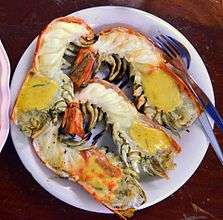Macrobrachium rosenbergii
| Macrobrachium rosenbergii | |
|---|---|
 | |
| Scientific classification | |
| Kingdom: | Animalia |
| Phylum: | Arthropoda |
| Subphylum: | Crustacea |
| Class: | Malacostraca |
| Order: | Decapoda |
| Infraorder: | Caridea |
| Family: | Palaemonidae |
| Genus: | Macrobrachium |
| Species: | M. rosenbergii |
| Binomial name | |
| Macrobrachium rosenbergii De Man, 1879 | |
Macrobrachium rosenbergii, also known as the giant river prawn, giant freshwater prawn, Malaysian prawn, freshwater scampi (especially in India: in West Bengal it is called golda chingdi), or cherabin, is a species of freshwater shrimp native to the Indo-Pacific region, northern Australia and Southeast Asia. This species (as well as other Macrobrachium) is commercially important for its value as a food source.[2] It is commonly called ulang or uwang in the Philippines.
While M. rosenbergii is considered a freshwater species, the larval stage of the animal depends on brackish water.[3] Once the individual shrimp has grown beyond the planktonic stage and becomes a juvenile, it will live entirely in fresh water.[3]
Description

M. rosenbergii can grow to a length over 30 cm (12 in).[2]
Morphotypes
Three different morphotypes of males exist.[4] The first stage is called "small male" (SM); this smallest stage has short, nearly translucent claws. If conditions allow, small males grow and metamorphose into "orange claws" (OC), which have large orange claws on their second chelipeds, which may have a length of 0.8 to 1.4 times their body size.[4] OC males later may transform into the third and final stage, the "blue claw" (BC) males. These have blue claws, and their second chelipeds may become twice as long as their bodies.[3][4]
Males of M. rosenbergii have a strict hierarchy: the territorial BC males dominate the OCs, which in turn dominate the SMs.[4] The presence of BC males inhibits the growth of SMs and delays the metamorphosis of OCs into BCs; an OC will keep growing until it is larger than the largest BC male in its neighbourhood before transforming.[4] All three male stages are sexually active, and females that have undergone their premating moult will co-operate with any male to reproduce. BC males protect the female until their shells have hardened; OCs and SMs show no such behaviour.[4]
Lifecycle
In mating, the male deposits spermatophores on the underside of the female's thorax, between the walking legs. The female then extrudes eggs, which pass through the spermatophores. The female carries the fertilised eggs with her until they hatch; the time may vary, but is generally less than three weeks. Females lay 10,000–50,000 eggs up to five times per year.[3]
From these eggs hatch zoeae, the first larval stage of crustaceans. They go through several larval stages before metamorphosing into postlarvae, at which stage they are 0.28–0.39 in (7.1–9.9 mm) long and resemble adults.[3] This metamorphosis usually takes place about 32 to 35 days after hatching.[3] These postlarvae then migrate back into fresh water.
See also
References
- ↑ S. De Grave; J. Shy; D. Wowor & T. Page (2013). "Macrobrachium rosenbergii". IUCN Red List of Threatened Species. Version 2013.1. International Union for Conservation of Nature. Retrieved 13 July 2013.
- 1 2 T. Y. Chan (1998). "Shrimps and Prawns". In Kent E. Carpenter; Volker H. Niem. The Living Marine Resources of the Western Central Pacific. Volume 2: Cephalopods, Crustaceans, Holothurians and Sharks (PDF). FAO Species Identification Guide for Fishery Purposes. Food and Agriculture Organization. ISBN 92-5-104051-6.
- 1 2 3 4 5 6 Forrest Wynne (May 2000). "Grow-out culture of freshwater prawns in Kentucky". Archived from the original on August 21, 2008. Retrieved July 4, 2005.
- 1 2 3 4 5 6 A. Barki; I. Karplus & M. Goren (1991). "Morphotype related dominance hierarchies in males of Macrobrachium rosenbergii (Crustacea, Palaemonidae)". Behaviour. 117 (3/4): 145–160. doi:10.1163/156853991x00508. JSTOR 4534936.
External links
| External identifiers for Macrobrachium rosenbergii | |
|---|---|
| Encyclopedia of Life | 344690 |
| ITIS | 96343 |
| NCBI | 79674 |
| WoRMS | 220137 |
